Back
Cybersecurity Best Practices to Prevent Cyber Attacks
- By Elite CIO
 Sep 12, 2022
Sep 12, 2022 25
25
 Cybersecurity Best Practices to Prevent Cyber Attacks
Cybersecurity Best Practices to Prevent Cyber Attacks
Staying secure against ransomware isn’t just about having the latest security solutions. Good IT security practices, including regular training for employees, are essential components of every network surface. Make sure you’re following these 10 best practices:
1. Patch early, patch often - Malware that doesn’t come in via a document often relies on security bugs in popular applications, including Microsoft Office, your browser, Flash, and more. The sooner you patch, the fewer holes there are to be exploited.
2. Backup regularly and keep a recent backup copy off-line and off-site - There are dozens of ways other than ransomware that files can suddenly vanish, such as fire, flood, theft, a dropped laptop, or even an accidental delete. Encrypt your backup and you won’t have to worry about the backup device falling into the wrong hands. Furthermore, a disaster recovery plan that covers the restoration of data and whole systems.
3. Enable file extensions - The default Windows setting is to have file extensions disabled, meaning you have to rely on the file thumbnail to identify it. Enabling extensions makes it much easier to spot file types that wouldn’t commonly be sent to you and your users, such as JavaScript.
4. Open JavaScript (.JS) files in Notepad - Opening a JavaScript file in Notepad blocks it from running any malicious scripts and allows you to examine the file contents.
5. Don’t enable macros in document attachments received via email - Microsoft deliberately turned off auto-execution of macros by default many years ago as a security measure. A lot of infections rely on persuading you to turn macros back on, so don’t do it!
6. Be cautious about unsolicited attachments - The crooks are relying on the dilemma you face knowing that you shouldn’t open a document until you are sure it’s one you want, but you can’t tell if it’s one you want until you open it. If in doubt leave it out.
7. Monitor administrator rights - Constantly review admin and domain admin rights. Know who has them and remove those who do not need them. Don’t stay logged in as an administrator any longer than is strictly necessary and avoid browsing, opening documents, or other regular work activities while you have administrator rights.
8. Stay up to date with new security features in your business applications - For example, Office 2016 now includes a control called “Block macros from running in Office files from the internet,” which helps protect against external malicious content without stopping you from using macros internally.
9. Regulate external network access - Don’t leave ports exposed to the world. Lock down your organization’s RDP access and other management protocols. Furthermore, use two-factor authentication and ensure remote users authenticate against a VPN.
10 Use strong passwords - It sounds trivial, but it really isn’t. A weak and predictable password can give hackers access to your entire network in a matter of seconds. We recommend making them impersonal, at least 12 characters long, using a mix of upper and lower case and adding a sprinkle of random punctuation.